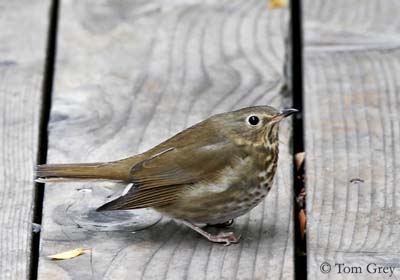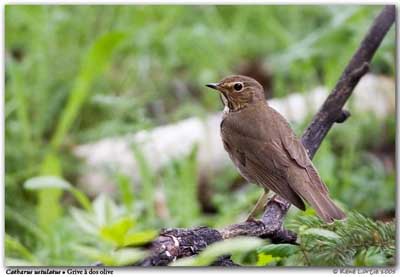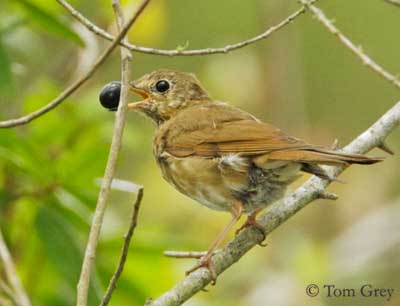
Swainson’s Thrush
Catharus ustulatus
Passeriforme Order – Turdidae Family
BIOMETRICS:
Length: 16-19 cm
Wingspan: 29-31 cm
Weight: 23-45 g
LONGEVITY: Up to 10 years
DESCRIPTION:
Swainson’s Thrush is rather warm olive brown above, and whitish below, with a distinct warm buff wash to the face, throat and breast, and a distinct buffish eye ring.
Underparts show more restricted spotting than in Song Thrush, being only weakly marked on lower breast and flanks.
Both sexes are alike.
Eyes are dusk. Legs and feet are flesh coloured. Bill is yellow with black tip. Immature is similar to adults.
Birds in the East are more olive brown above; western birds are more reddish-brown.
PROTECTION / THREATS / STATUS:
Swainson’s Thrush populations appear to be declining, but is a widespread breeding bird occupying much of forested North America.
They are however still vulnerable to loss of habitat on breeding and wintering grounds. Occasionally, Swainson’s Thrush is a host of Brown-headed Cowbird.
Fr: Grive à dos olive
All : Zwergdrossel
Esp : Tordo Olivo
Ital: Tordo di Swainson
Nd: Dwerglijster
Russe: Свэнсонов дрозд
Sd: Beigekindad skogstrast
Photographs by Tom Grey
His website:
Tom Grey's Bird Pictures
Photographs by René Lortie
His website: http://rlortie.ca/
Text by Nicole Bouglouan
Sources:
HANDBOOK OF THE BIRDS OF THE WORLD Vol 10 by Josep del Hoyo-Andrew Elliott-David Christie - Lynx Edicions - ISBN: 8487334725
THRUSHES by Peter Clement and Ren Hathway – HELM - ISBN: 0713639407
A GUIDE TO THE BIRDS OF MEXICO AND NORTHERN CENTRAL AMERICA by Steve N. G. Howell, Sophie Webb - Oxford University Press - ISBN: 0198540124
BIRDS OF THE GREAT BASIN – by Fred A. Ryser - Univ of Nevada Pr -ISBN: 0874170796
A GUIDE TO THE BIRDS OF COLOMBIA by Steven L. Hilty and William L. Brown - Princeton University Press – ISBN 069108372X
FIELD GUIDE TO THE BIRDS OF NORTH AMERICA - National Geographic Society - ISBN: 0792274512

VOICE: SOUNDS BY XENO-CANTO
Swainson’s Thrush is often silent. The most typical call is an emphatic, low, liquid “whit”. We can hear also a soft “whup”. Song is an ascending spiral of varied whistles. At night, a peeping “queep” is heard.
HABITAT:
Swainson’s Thrush favours coniferous or mixed forest, with rather open undergrowths, and also woodland thickets especially near streams. It winters in mature tropical forest, and secondary forest.
RANGE:
Swainson’s Thrush breeds from interior Alaska throughout most of Canada, southward to northern states in East, and through mountains in West and along Pacific coasts. It winters in Mexico and South America.
BEHAVIOUR:
Swainson’s Thrush forages near ground, but higher than other thrushes. It may occasionally fly-catch insects. In winter, it follows army-ants swarms. It gleans insects from vegetation, and also forages for other invertebrates on the ground. In late summer, they feed on berries. It hovers while gleaning insects from foliage, and also catches flying insects, sometimes even in the canopy.
Swainson’s thrush is shy and skulking, spending most of time on ground, under cover of undergrowth. It hops and will run in short bursts.
Swainson’s thrush is highly migratory. Migration is mostly at night, often found in mixed flocks with other thrushes.
Swainson’s thrush is seasonally monogamous, but pairs often re-form in multiples seasons after repeating the pair-bonding process. This may facilitate rapid pairing. Males arrive first; initially tries to drive arriving females on its territory. After several days of female persistence, which may de strengthened by the male’s defensive behaviour, male accepts female and mating occurs.

Swainson’s thrush sings from a high perch. It may flick its wings and raise its crest when agitated. When is performing an agonistic display (a behaviour used to threaten another bird) the bird draws its head back, raises its bill while moving it slightly to the side.
FLIGHT:
In flight, Swainson’s thrush appears entirely olive brown on the upperparts. It hovers while gleaning insects from foliage.
REPRODUCTION:
Male establishes a territory and attracts a female by singing. Swainson’s thrush’s nest is usually in a low conifer, sometimes in deciduous tree, at 2 to 10 feet above the ground. It’s a bulky open cup on a horizontal tree branch, built by female in about 4 days. It’s made of grasses, plants stems, moss, small twigs and mud. It is lined with skeletonised leaves, rootlets, lichens or moss, and animal hair.
Female lays 3 to 4 blue to greenish blue eggs, speckled with reddish or brown. Incubation lasts about 12 days by female. Chicks hatch helpless with some sparse down, and leave the nest at 12 days after hatching. Both parents feed them.
They produce a single brood per season.
DIET:
Swainson’s Thrush feeds on fruit, berries and insects. It also eats spiders and other invertebrates. Young are fed insects, and possibly some fruits.
